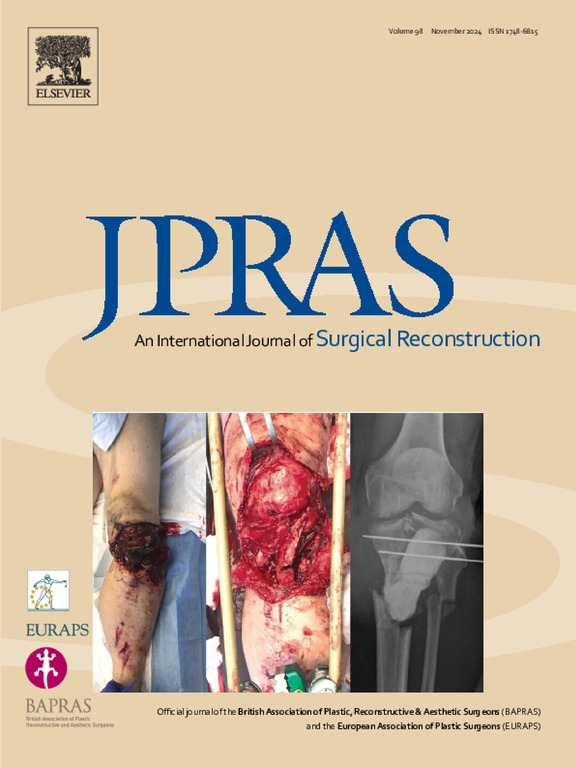Tissue expansion in the pediatric patient: A 23-year single-institution experience
IF 2
3区 医学
Q2 SURGERY
Journal of Plastic Reconstructive and Aesthetic Surgery
Pub Date : 2025-04-07
DOI:10.1016/j.bjps.2025.04.002
引用次数: 0
Abstract
Background
Given the wide and variable use of tissue expansion in pediatric soft tissue reconstruction, we aimed to characterize its use at our institution over the past 23 years, focusing on clinical outcomes stratified by location, indication, and repeat expansion.
Methods
A multi-surgeon retrospective review of all patients who underwent tissue expander (TE) placement from 2001–2024 was conducted. Demographic, operative, and outcomes data were collected and compared. Univariable and multivariable logistic regression were used to identify the predictors of complications and premature explantation.
Results
Overall, 211 patients with 519 TEs met the inclusion criteria. The most common diagnoses were congenital nevus (21.8%, n=46), scarring (21.8%, n=46), and omphalocele (12.3%, n=26). Successful reconstruction was achieved in 93.4% of the patients (n=197); 22.7% (n=48) underwent repeat expansion of the same anatomic location. Complications occurred in 24.5% (n=127) of the expanders and 16% (n=82) required premature explantation. On multivariable analysis, use in conjoined twins (OR 2.6, p=0.006), use for wound reconstruction (OR 6.1, p=0.047), and repeat expansion (OR 2.5, p=0.008) were associated with increased odds of complications. Expander placement at <3.5 years was associated with increased odds of premature explantation (OR 1.9, p=0.047).
Conclusions
Although pediatric tissue expansion allows effective soft tissue reconstruction in a multitude of anatomic locations and conditions, it remains a significant undertaking for families and is not without risk. Repeat tissue expansion, use in conjoined twins, and wound reconstruction are predictive of increased complications. Placement at <3.5 years of age may also increase the odds of premature explantation.
组织扩张在儿科患者:23年的单一机构的经验
背景:考虑到组织扩张在儿童软组织重建中的广泛和多变的应用,我们旨在描述其在过去23年中在我们机构的使用情况,重点关注按位置、适应症和重复扩张分层的临床结果。方法对2001-2024年所有行组织扩张器置入术的患者进行多外科医生回顾性分析。收集并比较了人口学、手术和结局数据。采用单变量和多变量logistic回归来确定并发症和过早外植的预测因素。结果211例519例TEs符合纳入标准。最常见的诊断是先天性痣(21.8%,n=46)、瘢痕形成(21.8%,n=46)和脐膨出(12.3%,n=26)。93.4%的患者(n=197)重建成功;22.7% (n=48)接受同一解剖部位的重复扩张。24.5% (n=127)的扩张器出现并发症,16% (n=82)的扩张器需要提前拔出。在多变量分析中,用于连体双胞胎(OR 2.6, p=0.006)、用于伤口重建(OR 6.1, p=0.047)和重复扩张(OR 2.5, p=0.008)与并发症发生率增加相关。3.5岁时放置扩张器与早产几率增加相关(OR 1.9, p=0.047)。结论尽管儿童组织扩张术可以在多种解剖位置和条件下进行有效的软组织重建,但对于家庭来说,这仍然是一项重要的工作,并不是没有风险。重复组织扩张、用于连体双胞胎和伤口重建可预测并发症的增加。3.5岁放置也可能增加早产的几率。
本文章由计算机程序翻译,如有差异,请以英文原文为准。
求助全文
约1分钟内获得全文
求助全文
来源期刊
CiteScore
3.10
自引率
11.10%
发文量
578
审稿时长
3.5 months
期刊介绍:
JPRAS An International Journal of Surgical Reconstruction is one of the world''s leading international journals, covering all the reconstructive and aesthetic aspects of plastic surgery.
The journal presents the latest surgical procedures with audit and outcome studies of new and established techniques in plastic surgery including: cleft lip and palate and other heads and neck surgery, hand surgery, lower limb trauma, burns, skin cancer, breast surgery and aesthetic surgery.

 求助内容:
求助内容: 应助结果提醒方式:
应助结果提醒方式:


